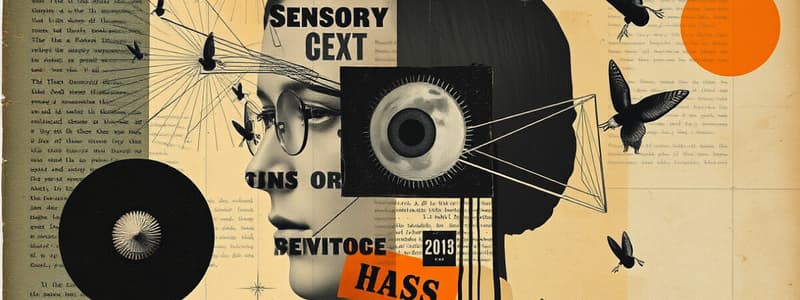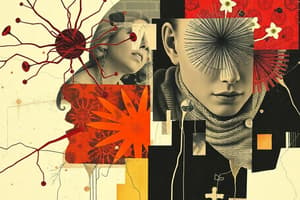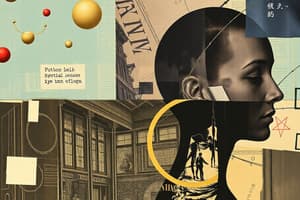Podcast
Questions and Answers
What are the five senses that help us connect with the external world?
What are the five senses that help us connect with the external world?
Touch, taste, smell, sight, and hearing.
How do special sense receptors differ from general sense receptors?
How do special sense receptors differ from general sense receptors?
Special sense receptors are either complex sensory organs like the eyes and ears or localized clusters like taste buds, unlike general receptors that are widespread.
What is the diameter of an adult human eye?
What is the diameter of an adult human eye?
About 1 inch or 2.5 cm.
What protects the surface of the eye?
What protects the surface of the eye?
What are some of the accessory structures of the eye?
What are some of the accessory structures of the eye?
Describe the relationship between sensory inputs and motor outputs in the context of the nervous system.
Describe the relationship between sensory inputs and motor outputs in the context of the nervous system.
What role does the blending of stimulus effects play in our sensory experience?
What role does the blending of stimulus effects play in our sensory experience?
Where is only one-sixth of the eye’s surface normally visible?
Where is only one-sixth of the eye’s surface normally visible?
What is the primary function of the cornea in the eye?
What is the primary function of the cornea in the eye?
How does the structure of the sclera contribute to the eye's protection?
How does the structure of the sclera contribute to the eye's protection?
What types of cells are considered photoreceptors in the retina?
What types of cells are considered photoreceptors in the retina?
What happens when the cornea is touched?
What happens when the cornea is touched?
Why is the optic disc significant in vision?
Why is the optic disc significant in vision?
What unique property does the cornea have regarding transplantation?
What unique property does the cornea have regarding transplantation?
Describe the pathway of electrical signals from photoreceptors to the brain.
Describe the pathway of electrical signals from photoreceptors to the brain.
What role do nerve endings in the cornea play?
What role do nerve endings in the cornea play?
What occurs to light rays from a distant object as they reach the eye?
What occurs to light rays from a distant object as they reach the eye?
How does the lens of the eye adjust for focusing on a close object?
How does the lens of the eye adjust for focusing on a close object?
Define refraction in the context of the eye's anatomy.
Define refraction in the context of the eye's anatomy.
What is astigmatism and how does it affect vision?
What is astigmatism and how does it affect vision?
Explain the term 'accommodation' in relation to vision.
Explain the term 'accommodation' in relation to vision.
What are the characteristics of light rays coming from close objects?
What are the characteristics of light rays coming from close objects?
What is emmetropia?
What is emmetropia?
Describe hyperopia and its impact on vision.
Describe hyperopia and its impact on vision.
What is the function of the lateral rectus muscle?
What is the function of the lateral rectus muscle?
Which cranial nerve is responsible for controlling the superior oblique muscle?
Which cranial nerve is responsible for controlling the superior oblique muscle?
Describe the action of the medial rectus muscle.
Describe the action of the medial rectus muscle.
Which muscles are primarily responsible for elevating the eye?
Which muscles are primarily responsible for elevating the eye?
What are the functions of the inferior rectus muscle?
What are the functions of the inferior rectus muscle?
What is the combined action of the inferior oblique muscle?
What is the combined action of the inferior oblique muscle?
How does the superior oblique muscle contribute to eye movement?
How does the superior oblique muscle contribute to eye movement?
Identify the role of the conjunctiva in the context of eye muscles.
Identify the role of the conjunctiva in the context of eye muscles.
What is emmetropia, and why is it referred to as 'harmonious vision'?
What is emmetropia, and why is it referred to as 'harmonious vision'?
Explain the condition myopia and what causes it.
Explain the condition myopia and what causes it.
What corrective lenses are required for myopia, and how do they work?
What corrective lenses are required for myopia, and how do they work?
Describe hyperopia and how it differs from myopia.
Describe hyperopia and how it differs from myopia.
What is the physiological basis of nearsightedness?
What is the physiological basis of nearsightedness?
How does the lens accommodate and what is its significance in vision?
How does the lens accommodate and what is its significance in vision?
What role does the ciliary muscle play in focusing vision?
What role does the ciliary muscle play in focusing vision?
What happens to the resting eye during hyperopia?
What happens to the resting eye during hyperopia?
Flashcards are hidden until you start studying
Study Notes
General and Special Senses
- Humans have five senses: touch, taste, smell, sight, and hearing; touch is a combination of general senses including temperature, pressure, and pain.
- Special sense receptors are divided into large complex organs like eyes and ears, or localized clusters such as taste buds.
Anatomy of the Eye
- The adult eye is roughly a 1-inch sphere (2.5 cm in diameter).
- Only one-sixth of the eye's surface is visible; most is protected by fat and bony structures.
- Structures around the eye include extrinsic muscles, eyelids, conjunctiva, and lacrimal apparatus.
Eye Muscles and Movements
- Lateral rectus (Cranial Nerve VI): Moves the eye laterally.
- Medial rectus (Cranial Nerve III): Moves the eye medially.
- Superior rectus (Cranial Nerve III): Elevates and rotates the eye medially.
- Inferior rectus (Cranial Nerve III): Depresses and rotates the eye medially.
- Inferior oblique (Cranial Nerve III): Elevates and rotates the eye laterally.
- Superior oblique (Cranial Nerve IV): Depresses and rotates the eye laterally.
Eye Structure
- The fibrous layer, consisting of sclera and cornea, provides protection.
- The sclera appears as the "white of the eye" while the cornea is transparent and allows light to enter.
- The cornea is rich in nerve endings and has the highest capacity for self-repair.
- The optic disc is a blind spot where no photoreceptors are present.
Photoreception and Vision
- The retina contains rods and cones, which are photoreceptors that respond to light.
- Light passes through a two-neuron pathway: photoreceptors signal bipolar cells, then ganglion cells.
- Information is transmitted to the brain via the optic nerve for interpretation.
Image Formation and Refraction
- Light refraction occurs as it passes through different eye substances (cornea, aqueous humor, lens, vitreous humor).
- Accommodation allows the lens to bulge for focusing on near objects.
Vision Conditions
- Emmetropia refers to properly focused images on the retina.
- Myopia (nearsightedness) occurs when light fails to reach the retina; the eyeball is usually too long.
- Hyperopia (farsightedness) happens when light focuses behind the retina; typically results from a short eyeball or lazy lens.
- Corrective lenses help focus light properly for each condition.
Studying That Suits You
Use AI to generate personalized quizzes and flashcards to suit your learning preferences.




